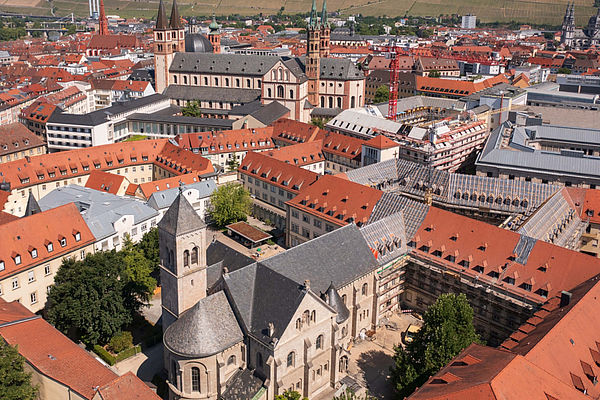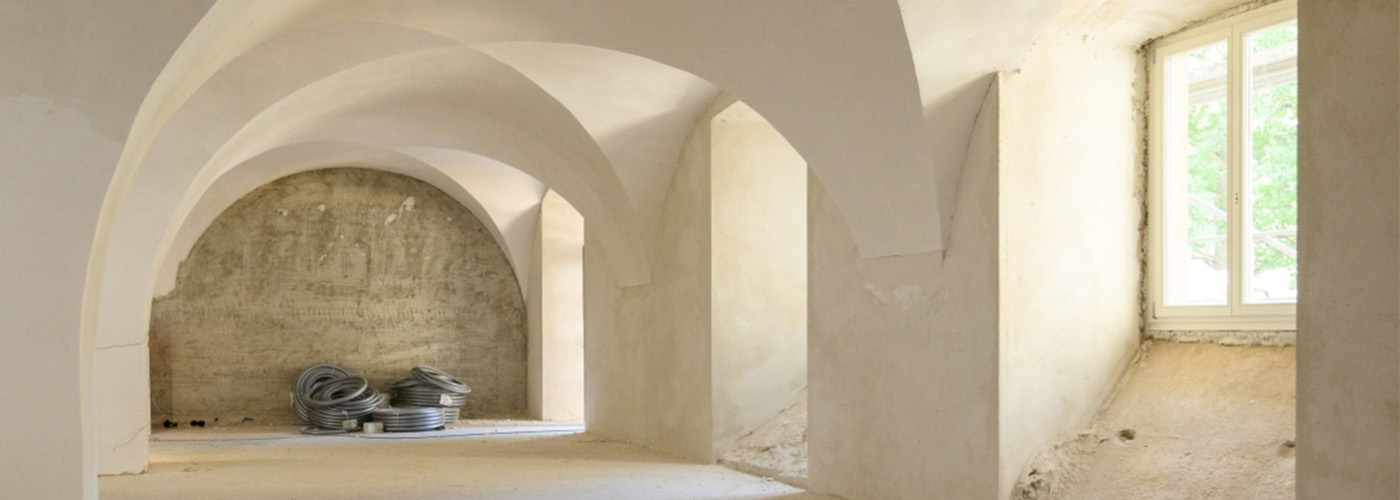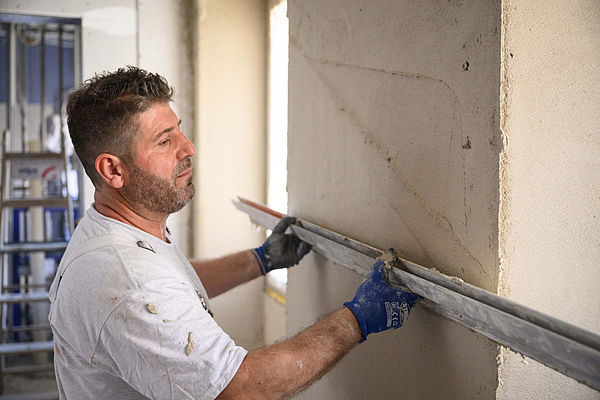Ecosphere | Congregation of the Sisters of the Redeemer
Destroyed during the war, rebuilt and now showing its age: The convent area of the Würzburg Sisters of the Redeemer, located in the city centre of Würzburg, is currently undergoing a comprehensive renovation. For the insulation of the exterior walls, the client and the responsible planners relied on the innovative Ecosphere spray insulation from maxit. With a purely mineral structure and enriched with hollow glass microspheres, it represents a new generation of building materials.
The entire motherhouse area, the centre of the Congregation of the Sisters of the Redeemer, is the largest contiguous property in Würzburg's city centre with its almost 15,000 square metres. The complete renovation, which began in 2020, is a major project that will not only bring the buildings up to date structurally and in terms of energy, but will also initiate a new orientation for the convent. "It is to open up to the outside world," says architect Sandra Räder, who is supervising the work as head of construction project management at the Sisters of the Redeemer. A public café is planned - exhibitions and concerts will now bring people to the sisters. Conversely, as in the past, this is becoming increasingly difficult for reasons of age. Therefore, all renovations will be barrier-free and the sisters will all have their own room with a bathroom. In future, seven or eight of them will share a common area with a living room, dining room and kitchen. This task - together with the fire protection - is a great challenge for the responsible architect's office, the church-affiliated "SBW-Bauträger- und Verwaltungs-GmbH" (Würzburg): After all, all structural interventions in the listed building must be closely coordinated with the authorities. The bar has also been set high in terms of energy, as the entire site is to be completely converted to renewable energies by 2037. The specified interior insulation is therefore subject to high energy requirements.
Tailor-made suit
As is often the case, the historical appearance of the building, which is a listed building, made interior insulation mandatory. This is delicate from a building physics point of view, as the dew point is predominantly between the insulation and the load-bearing masonry. The following applies to all possible designs: the insulation must be placed without cavities in order to prevent "condensation nests". This is difficult to achieve with insulation boards - especially with historic building fabric, which rarely has flat wall surfaces. The choice of a sprayable mortar-based insulation was therefore the logical consequence from a structural engineering point of view. In addition to the cavity-free, seamless application, this solution even allows the historical surface to be traced. Moreover, even complicated contours including vaults can be insulated without any problems. With the sprayable ecosphere interior insulation "maxit eco 71", those responsible ultimately opted for a product that, due to its extremely good thermal insulation properties of 0.040 W/(mK), also keeps the required layer thicknesses to a minimum. This is an invaluable advantage, especially in small rooms.
The mineral master of warmth
maxit eco 71 achieves its excellent thermal insulation value via hollow glass microspheres as lightweight aggregate. The static air enclosed in the glass spheres effectively prevents rapid heat transfer. Only a few cement crystals fix the thermally insulating hollow glass spheres and thus enable an extremely lightweight insulation material. The low weight is also partly responsible for the high stability of the mortar during spraying. This and its rapid setting enabled the seamless application of the required insulation thickness of 60 mm wet in wet, in one go, during the renovation of the monastery. The rheological properties of maxit eco 71 in combination with the adhesive primer "maxit eco 70" ensure sufficient plaster adhesion at the applied plaster thickness without the need for an additional plaster base.
Due to the embedded hollow glass microspheres, the sprayable insulation has a multicellular plaster structure that basically resembles the structure of a human bone. The result is maximum strength with low weight and minimal material consumption. 100 mm plaster thickness without plaster base is thus possible without any problems. With a plaster base, a thickness of up to 150 mm can be applied. Due to the energy specifications, the building owners decided to use an energy-efficient wall heating system. The pipe system of the hot water heating system was placed directly on the 60 mm sprayed insulation and then embedded in 25 mm lime plaster. A second layer of 15 mm lime plaster forms the final layer. The heavy, (desired) thermally conductive lime plaster piggybacks on the light sprayed insulation. There are, of course, limits to the statics here, so before the heating systems were installed, a Distanet plaster base was applied to the ecosphere insulation to ensure a stable bond.

The centre of the Congregation of the Sisters of the Redeemer is the largest contiguous property in Würzburg's city centre with its almost 15,000 square metres.
For an area of just over 10,000 square metres, maxit supplied a finely tuned range of plasters: lime plaster, lime-cement plaster and maxit eco 71. Including the niche and ceiling connections, around 5,750 square metres were renovated with the innovative interior insulation. These quantities were also a challenge in terms of construction site logistics. The inner-city location leaves little room for delivery or storage space. With its enormous yield of 7,200 litres per tonne, ecosphere spray insulation had a good argument on its side. However, it was far more decisive that the manufacturer maxit, with its corresponding silo technology, can easily convey the maxit eco 71 over a distance of up to 80 metres. In reality, this meant that the entire construction site could be supplied via several centrally placed 18 cubic metre silos. This possibility simplified the construction site logistics considerably.
Ecological goal fulfilled
Highly efficient thermal insulation yes, but only under certain conditions. For the renovation of the monastery, the client and planners also set high standards in terms of ecology for the building materials used. With the sprayable interior insulation maxit eco 71, the choice fell on a purely mineral plaster system that also achieves high insulation performance with minimal material input due to its multi-cellular structure. In contrast to building sand, a raw material that is dwindling worldwide, the hollow glass microspheres are made of various sands whose continued existence is assured. Incidentally, this "insulating material" also enables the plaster to be classified as "non-combustible" (A1). Free of pollutants, with a purely mineral structure, masonry or concrete can be completely shredded together with maxit eco 71 and sent for recycling. A thought that is not current in this project, but: ecologically responsible renovation means thinking about the end, even in listed buildings.

